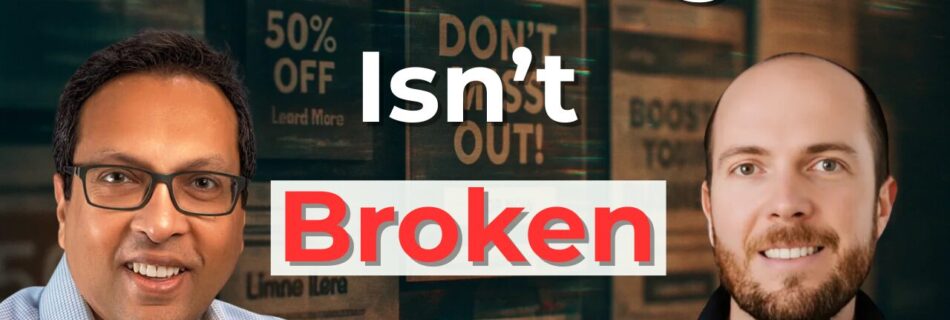Why Traditional Sales Is Dead—and What You Should Do Instead
The sales landscape has shifted, and if you’re still using outdated tactics, you’re not just behind—you’re losing. In our latest Scale Smart Grow Fast podcast episode, Harley Green sits down with sales strategist and bestselling author Joe Candido to unpack what today’s B2B buyers really want—and how sales leaders can meet them there.
Preferred listening on the go? Catch the full podcast episode on Spotify and Apple Podcasts.
🎯 Traditional Tactics No Longer Work
Buyers today are informed, empowered, and immune to product pitches. Joe makes it clear: “No one wants to hear about your company—they want value.” If your sales team is leading with features instead of outcomes, you’re doing it wrong.
💡 Enter Leadership Selling
Joe introduces his game-changing framework: Leadership Selling. This approach prioritizes:
- Selling to decision-makers (not just gatekeepers)
- Understanding client business goals
- Delivering value before asking for anything
- Focusing on business outcomes over product specs
🧠 Mindset Shifts That Drive Growth
Leadership selling isn’t just a strategy—it’s a mindset. Joe urges sales leaders to:
- Assess team competencies, not just skills
- Coach based on forward-looking activities (not just closed deals)
- Stop chasing RFPs unless you helped write them
- Be involved—review deals, negotiate, coach in the field
🛠 Tools & Time Management
Joe highlights that most salespeople spend less than 20% of their time actually selling. His fix? Leverage tech—like CRMs and AI—for research, scheduling, and admin tasks. But streamline it. “If the system frustrates your reps, they’ll game it,” he warns.
✅ Pro Tip to Boost Revenue Now
Joe’s go-to strategy: Gather your team, review all current opportunities, and prioritize the top-tier deals you can realistically close this month. Focus energy there and watch results accelerate.
Bottom Line: If you want to lead a modern, high-performing sales team, stop selling like it’s the 90s. Start leading with value, insight, and strategic intent.
📘 Learn more about Joe’s work: https://leadership-selling.com
Schedule a discovery call to explore how strategic delegation and leadership support can help your sales team close more deals and scale faster.
Like what you read? Get weekly insights on scaling, efficiency, and profitability—straight to your inbox. Click here to subscribe.Transcript
Harley Green: Hey everybody, welcome back to the Scale Smart Grow Fast podcast. I’m host Harley Green. And as you may know in business sales, sales is not just a department. It’s the engine of scale in a business. In this episode, Joe Candido, sales strategist and author of Leadership Selling, reveals why traditional sales tactics are failing and what today’s buyers actually expect. Joe shares how sales leaders can transform their teams into trusted business advisors that drive revenue, loyalty and long-term growth by focusing on outcomes, not pitches. Joe, welcome to the podcast. How are you today?
Joe Candido: I’m doing great Harley, nice to see you and thanks for having me here.
Harley Green: It’s our pleasure. Now, Joe, can you maybe elaborate a little bit, give the audience more background about what’s brought you to helping other people scale their sales teams.
Joe Candido: My career has really been a journey in sales. I started in the tech sector. And I quickly figured out that if I didn’t understand my customer’s world, I was never going to succeed at selling anything to them. They didn’t care about the technology. They cared about something that was happening in their business that the technology might be able to help them with. So it caused me to shift how I approached sales. Initially, I was all about the product. I had to learn the product features, I had to do a great demo, but it was completely my agenda, product centric. Product is important. It’s foundational knowledge. You have to have it, but that’s not the end state. That’s the beginning of the journey with the customer. You have to be knowledgeable about their world and then show them how the product or service you represent can be of value to them in their world. So it’s really a shift from a me-centric approach to a client-centric approach.
Harley Green: You’ve said that traditional selling is dead. What do you believe has changed most in how sales needs to be done today?
Joe Candido: The buyers are way more savvy than they used to be. Today we have so much information as buyers. We’ve got the internet and we have access to competitors. We have a global landscape. We can source goods and services from a really large geography. This is true whether you’re selling nationally or locally, whether you’re a small company, mid-size company, or a multinational. The buyers are sophisticated and they know a lot. They’re trying to find someone who can bring value beyond what they can get on their own. So the question we all need to ask is, why should someone buy from me? What am I doing beyond the core service and product, beyond my competitors, that causes the buyer to say, I want to work with you? That’s why traditional selling is dead. Dialing for dollars, working through a list, and pitching people doesn’t work. They don’t care about your company or product until you’ve earned the right. If a buyer really wants to know about your company, they’ll ask. Until then, offer value first.
Harley Green: What are some tips or strategies to help identify what that value might be with your ideal client and really distinguish yourself from the competition?
Joe Candido: First, to be clear, I’m talking about business-to-business selling. We’re assuming salespeople are engaging by phone, face-to-face, or Zoom. This isn’t Amazon. You need to do your homework. Know who you’re calling and why. Know the company, the person, their title, and what challenges they might be facing. Have something of value to share that is not a pitch. It could be a white paper, a trend, something about their industry—something helpful. This demonstrates you know their world. Sometimes you have to do this two or three times before they’ll trust you enough to talk. You might email something, leave a voicemail, or follow up with more insights. Build trust.
Harley Green: One thing you talk about a lot is leadership selling. How is leadership selling different from what most sales teams are currently doing?
Joe Candido: Leadership selling means be a leader and sell to leaders. We usually sell to the middle or lower part of the organization because we think it’s easier. But they often don’t have buying authority. Or they buy based on strict criteria, usually focused on price. Leaders are paid to change the business. Managers run it. When you sell to a leader, they know the goals, they know where they’re trying to take the company. They want to hear about trends, competitors, and what can help them hit their objectives. And they have the authority and budget to act. You can reach them if you’re prepared with insights. I’ve seen it done time and again.
Harley Green: Tell us some tips or strategies to make sure you’re able to speak with those leaders and decision makers.
Joe Candido: The gatekeeper can be your best ally. Their job is to open the gate, not just close it. So don’t go around them—talk to them. They answer the phone. Be transparent: “I need to speak to your boss and here’s why.” Explain the value you bring. Say you work with executives like theirs and want to share some trends. When they say they’ll check with their boss, explain that the boss will have questions they can’t answer—and will want to get a feel for you personally. Offer a quick, 2–3 minute chat. That approach works 70% of the time.
Harley Green: Let’s shift to mindset. What are some mindset shifts that sales leaders and salespeople need to make?
Joe Candido: One shift is focusing on competencies, not just knowledge. Many salespeople know what to do but don’t do it—especially when it comes to prospecting. We need to assess teams and understand the gaps. Managers need to stop just telling people what to do and start coaching how to do it. Also, shift from looking backward (at reports) to looking forward. Ask what they’re doing today to be successful tomorrow. Focus more on activity than just results. Results matter, but activity drives them. Set clear expectations—like five appointments this week—and help them get there. Leaders need to get involved: join sales calls, review proposals, help negotiate. Be present.
Harley Green: That’s something we see often too—leaders delegate too much. What are other common mistakes you see from leadership?
Joe Candido: One big one is not having a clear sales strategy. Everyone’s doing something, but not all rowing in the same direction. Leaders must define how the team will win. What differentiates us? Make it client-centric and focused on business outcomes. Help clients reach their goals—that’s where value is, and it leads to loyalty. You’ll justify your pricing when you can demonstrate ROI. Don’t chase RFPs unless you helped write them. They’re usually just to validate someone else’s price, and even if you win, you’ll have no relationship or margin. Stick to your plan. Target clients who are a good fit.
Harley Green: When is the right time to delegate to executive assistants so the sales team can focus on high-value activities?
Joe Candido: Time management is crucial. Most salespeople spend less than 20% of their time selling. Improve that by training and using systems. Handle emails during off-peak hours. Use AI and CRMs wisely—don’t bog people down with admin. Use AI for rough drafts, scheduling, research, and reminders—but validate its output. Tools can save time, but they shouldn’t become the job. Use them to support sales, not slow it down.
Harley Green: What kind of systems help keep teams consistent and high-performing despite all these tools?
Joe Candido: I use a framework called QQVB: Quantity, Quality, Velocity, and Balance. Your CRM and funnel should be simple and auto-generated from daily sales activities. Don’t ask reps to enter the same data in multiple places. And don’t punish them when forecasts miss—otherwise, they’ll game the system. If deals are stuck, coach, don’t blame. Understand the problem and help fix it. QQVB lets you identify bottlenecks and coach more effectively.
Harley Green: Joe, what’s one actionable step sales teams should take right now?
Joe Candido: Gather your team, look at every opportunity, and rank them. Focus your energy on the top 5, 10, or 20 that are most likely to close this month. Collaborate as a team to prioritize and close. This drives immediate results and builds great habits.
Harley Green: Joe, how can people connect with you?
Joe Candido: Go to leadership-selling.com. You’ll find my book and contact info. No strings—happy to chat.
Harley Green: Thank you so much, Joe. And thanks to everyone tuning in. If you got value from this episode, like, subscribe, and share. We’ll see you next time.










